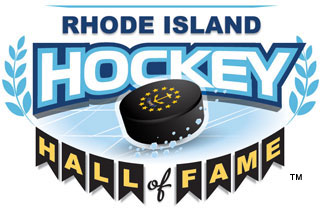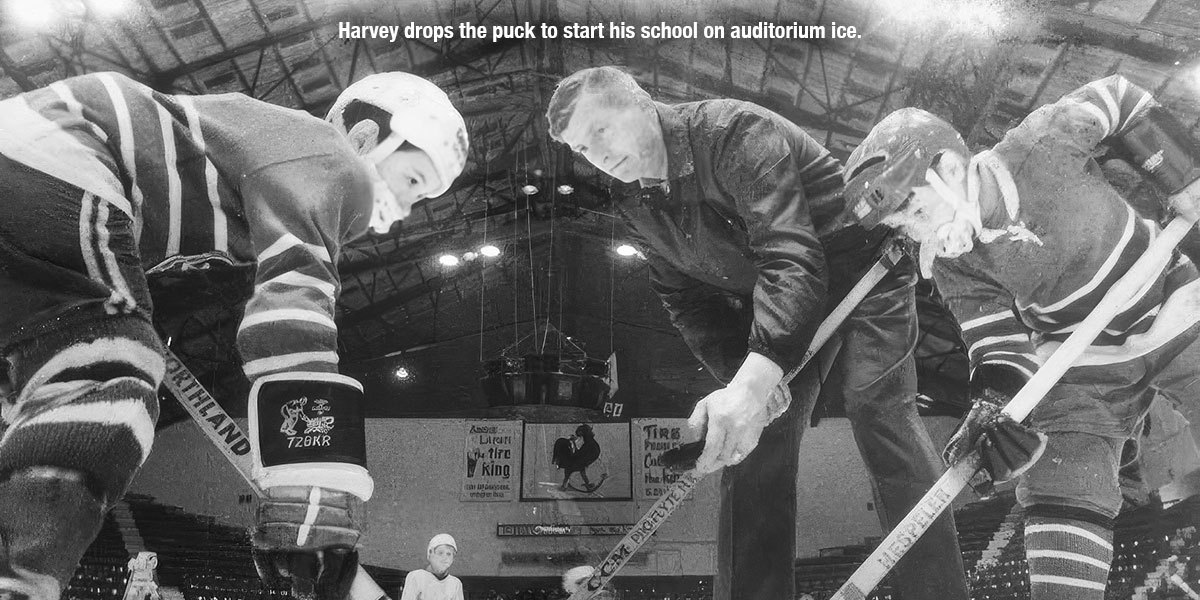If you were a good young hockey player in Rhode Island in the 1960s or if you dreamed of becoming one, the place to be on Sundays at noon was the Rhode Island Auditorium.
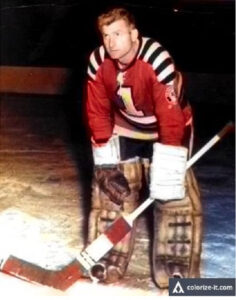 That’s when Harvey Bennett’s hockey school took the ice thanks to the generosity of Reds and Auditorium owner, Lou Pieri, and the affection he had for his star goalie.
That’s when Harvey Bennett’s hockey school took the ice thanks to the generosity of Reds and Auditorium owner, Lou Pieri, and the affection he had for his star goalie.
For a dollar, you could skate for an hour under the watchful eyes of instructors Bennett and Norm Calladine, both former Providence Reds and Boston Bruins who settled in Rhode Island after their playing days. Current Reds players sometimes showed up to help, including Eddie Giacomin, who would work with the goalies before he was traded to the New York Rangers and embarked on a Hall of Fame NHL career.
 The impact that the school had on the growth of hockey locally can’t be underestimated. A remarkable number of alums developed into some of the best players in the long history of the game in Rhode Island – NHLers, All-Americans and Olympians.
The impact that the school had on the growth of hockey locally can’t be underestimated. A remarkable number of alums developed into some of the best players in the long history of the game in Rhode Island – NHLers, All-Americans and Olympians.
“All the top players who were looking for a little extra ice time would be there,” recalls Jim Bennett, one of Harvey and Diana Bennett’s six sons.
To put the influence of the Bennett school in context, it’s important to note that it had its roots in an era when the Reds were the kings of the local hockey scene.
“Those guys, they were like gods,” remembers Jim Bennett.
For youngsters who attended the hockey school, it was a thrill to skate on the same ice the pros used.
 “We all went to the games and (the Reds) were our heroes,” said Tom Mellor, one of the most accomplished of the hockey school alums. He went on to play for the Detroit Red Wings in the NHL and to earn a silver medal with the United States team in the 1972 Olympics. Mellor was inducted into the Rhode Island Hockey Hall of Fame in 2022.
“We all went to the games and (the Reds) were our heroes,” said Tom Mellor, one of the most accomplished of the hockey school alums. He went on to play for the Detroit Red Wings in the NHL and to earn a silver medal with the United States team in the 1972 Olympics. Mellor was inducted into the Rhode Island Hockey Hall of Fame in 2022.
“And then we could play (at the Auditorium) on Sunday? Oh, my God. We’re playing where the Reds played! That was a great experience for me as a kid.”
Billy Payne feels the same way. He grew up on 10th Street in Providence, a short walk from the Auditorium, and his uncle, Ray Cyr, spent a couple of seasons with the Reds in the 1950s. Five-plus decades later, Payne still savors the opportunity he had to skate at the Auditorium and to interact with players that he idolized.
“Bobby Leduc (who spent seven-plus years with the Reds) would be out there sometimes. It was just great. You were in awe of those guys. I was just learning how to skate then and it was all new and exciting,” said Payne, who played high school hockey for La Salle Academy and Mount St. Charles and then at the University of New Haven.
Players of all ages and abilities were welcome.
“You would get the kids who really wanted to play. You had to get up. It was Sunday morning. You had to go to Providence. I got to play with all my brothers because there was no age group. Big guys would play with the little guys,” said Jim Bennett.
“We’d work on some things, maybe one or two drills and then right to scrimmaging. That’s what was fun. The passion would come from scrimmaging. (Harvey would) get the young kids out there, then the pretty good kids and then the older guys. Blow the whistle after a couple of minutes and shift it up,” he said.
As far as instruction went, said Mellor, “They’d get into some of the little finer points. They’d stop and actually tell you, you know, you don’t want to pass across the middle in your own end. Try to go behind the net. Little things like that. Then it was how to cut to the net, how to put your leg out, how to do this, how to do that. A drop pass. A tip in. All those little finer points of the game. It was wonderful.”
Jim Bennett recalls that if a younger player was good enough, he could play with the older players.
“It was not structured. It was not 12-year-old playing against 12-year-old. If a 12-year-old could keep up, he’d play with the 18-year-olds. I don’t know if you could do that today, but it was pretty cool,” he said.
The Reds often played at home on Sunday nights in those days. The team would have its morning skate and “the guys that weren’t dressing that night, they came out for the hockey school and they skated with us,” said Bill Bennett.
 Sometimes there was only one goalie, so a skater would jump into the other net for the scrimmage, which led to some memorable moments.
Sometimes there was only one goalie, so a skater would jump into the other net for the scrimmage, which led to some memorable moments.
“(Reds defenseman) Jules ‘Choo Choo’ Bouchard, he couldn’t speak much English. Choo Choo, I guess, didn’t understand that you didn’t have any goalie equipment on and he would come down and blast. It was too much,’’ Bill Bennett said with a laugh.
Exposure to coaching from men who had played the game for a living made a difference. “My mom used to always say, ‘Amateurs teach amateurs to be amateurs,’” said Bill Bennett.
“The old pros were more about passion and being an athlete. They believed that you would learn your skills through playing the game,” said Jim Bennett.
According to Bill Bennett: “(Harvey) knew that passion was the thing that carries over. You can’t instill the passion that it takes to be a hockey player. Some guy just yelling at you all the time, telling you what to do, that doesn’t work. (The player) has to find the passion to play.
“Now (parents of young players are) thinking Division I, NHL. Honest to God, we just wanted to play. We loved playing street hockey. We loved shooting pucks. We never thought anything would ever happen with this game. No one expected anything.”
Expectations or not, a remarkable number of young Rhode Island players built on the foundation that was put down at noon on Sundays at the Rhode Island Auditorium and went on to great things in hockey.
Curt Bennett was an All-American at Brown. He played for the St. Louis Blues, New York Rangers and Atlanta Flames.
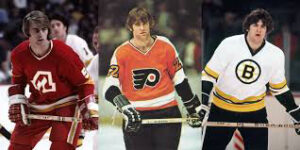 Harvey Bennett Jr. played at Boston College and went on to play for the Pittsburgh Penguins, Washington Capitals, Philadelphia Flyers, Minnesota North Stars and St. Louis Blues.
Harvey Bennett Jr. played at Boston College and went on to play for the Pittsburgh Penguins, Washington Capitals, Philadelphia Flyers, Minnesota North Stars and St. Louis Blues.
Bill Bennett, who has continued the legacy of his Hall of Fame father’s clinics for decades from his skate and hockey shop at the Cranston Veterans Memorial Ice Rink, played for the Boston Bruins and the Hartford Whalers.
 John Bennett, now “Dr.” John Bennett, played for the Philadelphia Blazers of the World Hockey Association.
John Bennett, now “Dr.” John Bennett, played for the Philadelphia Blazers of the World Hockey Association.
Jim Bennett played for the Muskegon Mohawks of the International Hockey League and the Birmingham Bulls of the Central Hockey League.
Tom Mellor was an All-American at Boston College. He played on the silver-medal United States team at the 1972 Olympics and skated twice for the U.S. in the IIHF World Championship. He went on to play for the Detroit Red Wings and earned MVP honors in the IHL with the Toledo Goaldiggers.
Joe Cavanagh was a three-time All-American at Harvard. He likely would have played in the NHL if he hadn’t been injured during Olympic tryouts and instead chose to pursue a career as an attorney. He was elected to the United States Hockey Hall of Fame in 1994.
Tim Regan played on Boston University’s NCAA national champions in 1971 and 1972. He was a member of the U.S. team that won silver in the 1972 Olympics. As a pro, he played for the Hershey Bears in the American Hockey League.
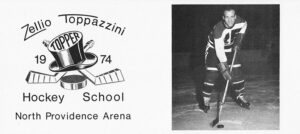 Dan DeMichele was a star hockey and baseball player at Harvard.
Dan DeMichele was a star hockey and baseball player at Harvard.
John Harwood earned All-Ivy honors, was captain at the University of Pennsylvania and an Olympics candidate.
Rich McLaughlin played at Brown. And on it goes.
Over the years, after Harvey’s original clinics had moved from Auditorium ice to newer suburban rinks, many other former Reds ran clinics and hockey schools of their own. Among them were Zellio Toppazzini, Fernie Flaman, Nick Polano, Serge Boudreault, and Ross Brooks. And while many spawned talented players, none could match the mystique and atmosphere of the originals with Harvey on the ice of the legendary Arena – the RI Auditorium.
By Mark Divver
